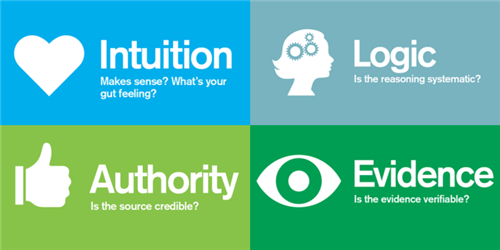By Donnetta Elsasser, OER Project Teacher
Washington, USA
Note: Over the next few months, we'll be bringing back (and updating) some of your favorites from the old BHP Teacher Blog. Enjoy this piece, originally posted September 27, 2020.
If you’d like to delve even deeper into the topic of claim testing then head over to Session 8 of Teaching Big History or Session 2 of Teaching World History for more!
I want my students to think before they pass along potential misinformation. I also want them to develop a healthy skepticism to their learning. That’s why the OER Project’s practice of claim testing fits so nicely with my educational philosophy. Authority, evidence, logic, and intuition. We should use those as often as our highlighters and Ticonderogas.

Since I’m always asking kids to question the information they encounter, introducing claim testing is more about new vocabulary than new ideas. I tell them that claim testing is the OER Project’s way to have them decide what to believe. It’s a set of filters to apply to new information (claims) in order to examine (test) what information is credible and trustworthy. So, how do they work?
Claim testers make us stop and think, instead of passively receiving knowledge. They make us ask ourselves questions like, “Where did this come from? Is this an authority I can trust?” The example I always use: If I wanted to know some statistics about cancer rates for smokers, whom should I trust—The American Heart Association, or Bob and Tom’s Smoke Shop? That usually leads to a good discussion of why we see certain people or entities as authorities and also how we can detect bias.
Even when we can trust an authority, we should still look for evidence to back up the statements we hear or read. Are these claims based on evidence, or just hearsay? Most established authorities will readily supply evidence, which is part of what helped them become authorities. But what if evidence comes from an unrecognized source? In addition to trying to find out more about the source, we can apply another claim tester to the information—logic. We can use logic and ask ourselves if the information makes sense. If it does, that’s one step closer to its believability.
There is one more claim tester in the OER Project storehouse, and that is to ask, “What does my gut tell me?” This is especially good for people who rely on their intuition to guide them through decision making. Don’t discount this one, even if you’re more of a thinker than a feeler. Sometimes information is presented in a logical manner with evidence and authority to back it up, but it just seems “too good to be true.” If your gut is telling you to call for backup, then you should probably listen to your gut.
Claim testers come to be an automatic filter during discussions, when evaluating websites, listening to speeches, or while reading articles. As students get more sophisticated, claim testers can also be incorporated into writing. Students can establish credibility of a source by speaking to its authority. Or, when including a counterclaim, a student can question the logic of an opposing argument, or the lack of evidence to support an opposing view.
It’s important to revisit this concept multiple times during the year. At the start of the year, students are just claim testing simple statements. Later, they learn to use claim testing to structure the way they talk with one another. Rather than simply disagree, they’ll say, “What’s your evidence?” or “Who’s the authority making that claim?” Later still, it will structure their writing as they learn to write in a way that addresses claim testing up front.
So, really, claim testing is a new name for an idea that has been around in our classrooms for a long time. When we draw attention to the device enough, students will start to depend on it as much as any other school supply in the back pack.
About the author: Donnetta Elsasser began teaching the Big History Project in 2014. She teaches at Touchet School in southeastern Washington. Her school runs a year-long BHP course for ninth graders. It meets five days a week, for 50-minute periods.
 For full access to all OER Project resources AND our amazing teacher community,
For full access to all OER Project resources AND our amazing teacher community, 